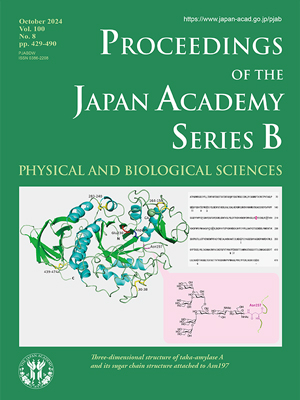About the Cover
Vol. 100 No. 8 (2024)
Aimoto et al. (pp. 429–445 in this issue) introduces a seminal paper by Shiro Akabori in the Proceedings of the Japan Academy, illustrating their pioneering contribution to protein science in Japan.
Akabori focused on taka-amylase A (TAA) considering its stability and wide availability in Japan. Chemical studies initiated in 1935 successfully crystallized the enzyme in 1951. Subsequently, analyses of its amino acid sequence, sugar chain structure, and three-dimensional structure were initiated.
Parallel to amino acid sequencing, they focused to the sugar chain moiety in TAA. In the 1960s, little was known on the sugar chain structure as well as its glycosylation sites to proteins. For this purpose, they applied several laborious chemical analysis methods to address the sugar composition, the linkage position, the branching structure, the anomers, and the consensus amino acid sequence for glycosylation of TAA. It was revealed that the sugar chain was high mannose-type and had a uniform structure though in rare cases. This sugar chain structural analysis of TAA is ranked a pioneering study in glycoscience, which promoted advances in glycobiology.
Crystals of TAA suitable for X-ray diffraction analysis were prepared using ammonium sulfate as a precipitant. During that time, TAA had the largest molecular weight target for crystallographic analysis. A three-dimensional model of the protein was constructed at 3 Å resolution by matching the determined amino acid sequence. TAA is the first amylase to have an amino acid sequence and three-dimensional structure.
The sugar chain was bound to Asn197, and Ca2+ contributed to the maintenance of the catalytic cleft structure. TAA inhibitors were bound in the vicinity of Glu230, suggesting that this vicinity is the enzyme catalytic site. Amino acid residues, presumably constituting the substrate binding sites, were highly conserved in porcine pancreatic α-amylase and TAA. Considering the accumulation of data on α-amylases of the same family, Asp206 and Glu230 were potential catalytic residues, functioning as a nucleophile and a proton donor (acid/base), respectively.
The coordinates were registered in the Protein Data Bank in 1982. Structural analysis of TAA was a landmark achievement in protein crystallography in Japan. The structural model of TAA was registered as Chemical Heritage by the Chemical Society of Japan.
Tomitake Tsukihara
Professor Emeritus, Osaka University




